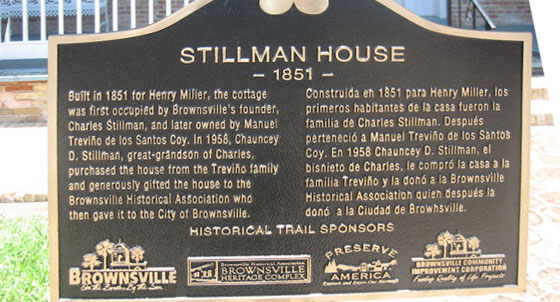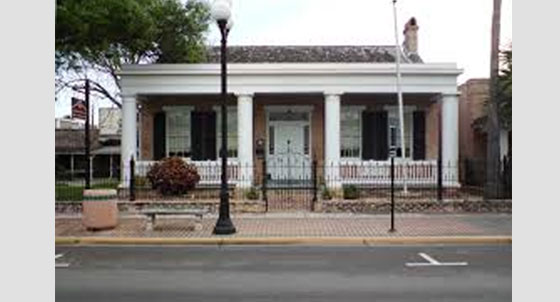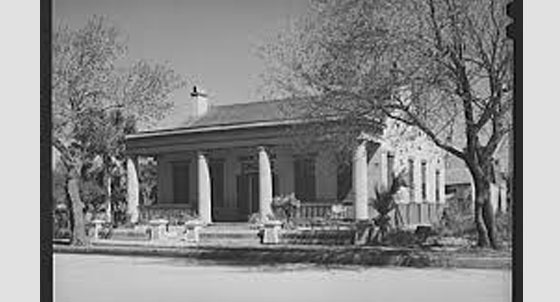Stillman House
Like the historic Neale House, the Stillman House and its original owner, Charles Stillman, were characteristic of the Civil War Era in the Rio Grande Valley. Born in Connecticut, Stillman arrived in Matamoros in 1828 and established a variety of enterprises in Northern Mexico. During the U.S.-Mexican War, Stillman partnered with Richard King and Mifflin Kenedy to transport U.S. troops and supplies from the Rio Grande delta to Mexico's interior. When the war ended and Mexico was forced to give up its northern territories, Stillman and his partners turned their attention to acquiring lands on the river's north bank which he later sold for the settlement that would become Brownsville. When the Confederacy seceded from the Union, Stillman and his partners obtained a contract to transport cotton across the Rio Grande, helping Confederate growers evade the Union blockade. Some of the cotton Stillman sent to his own textile factories in Monterrey. He loaded cotton onto his fleet of steamboats, which now were registered as Mexican flagged ships, and steamed them safely and legally past the warships in the Gulf. Such trade prolonged the war by providing important revenue for the Confederacy. Befitting a true profiteer willing to trade with both sides, Stillman also shipped cotton into Union ports, even selling to the U.S. government. By 1865, he had become one of the richest men in the United States. Stillman later abandoned the steamboat business and invested his money in several banks, including National City Bank of New York—today known as Citibank. Having made his fortune, he also left his home in Brownsville to move to New York—where he died in 1875.
Listen
De manera similar a la histórica Casa Neale, la Casa Stillman y su propietario original, Charles Stillman, son dos elementos que caracterizan la época de la Guerra de Secesión estadounidense en El Valle del Río Grande. Nacido en Connecticut, Stillman llegó a Matamoros en 1828 y emprendió diversos negocios en el norte de México. Durante la Guerra Méxicoestadounidense, o Guerra de Intervención, Stillman se asoció con Richard King y Mifflin Kenedy para transportar tropas y suministros desde el delta del Río Grande hacia el interior de México y, cuando el conflicto concluyó y México fue forzado a rendir sus territorios septentrionales, Stillman y sus socios se interesaron en la adquisición de tierras en la margen norte del río, las cuales venderían posteriormente para establecer el asentamiento que acabaría convirtiéndose en Brownsville. Cuando la Confederación se separó de la Unión, Stillman y sus socios obtuvieron una concesión para el transporte de algodón a través del Río Grande, ayudando así a que los productores esquivaran el embargo marítimo. Parte de los cargamentos de algodón se enviaban a las propias fábricas que Stillman poseía en Monterrey. Así, cargaba el algodón en los vapores registrados bajo bandera mexicana, lo que les permitía navegar con toda seguridad y dentro de la legalidad por el Golfo de México entre los navíos de guerra. Este tipo de tráfico comercial contribuyó a la mayor duración de la guerra, a causa de los importantes ingresos que suponía para la Confederación. Cumpliendo con su naturaleza de auténtico especulador en tiempos de guerra, no dudaba en comerciar con ambos bandos, llevando cargamentos de algodón también a los puertos unionistas y vendiéndoselos incluso al gobierno de los EE.UU. Para el año 1865 ya se había convertido en una de las personas más ricas del país. Posteriormente, abandonó el negocio de los vapores e invirtió su capital en diversos bancos, incluyendo el National City Bank de Nueva York –hoy conocido como Citibank– y, tras haber amasado su fortuna, allí se mudó, dejando atrás Brownsville y su casa, hasta su muerte en 1875.
Escucha
Details
Location: Brownsville Heritage Museum, Stillman House
1325 E Washington St, Brownsville, TX 78520
Access: Tuesday - Saturday: 10:00am to 4:00pm | Sundays - Mondays: CLOSED
Contact: Brownsville Heritage Complex | 956-541-5560 (phone) | 956-541-5524 (fax)
Cost of Admission: The Heritage Museum includes the Heritage Museum, the Stillman House Museum, and on-going exhibitions in both locations.
Adult Admission: $5.00
Senior Admission: $4.00
Student Admission: $2.00
Children under 6: FREE
BHA Members: FREE



